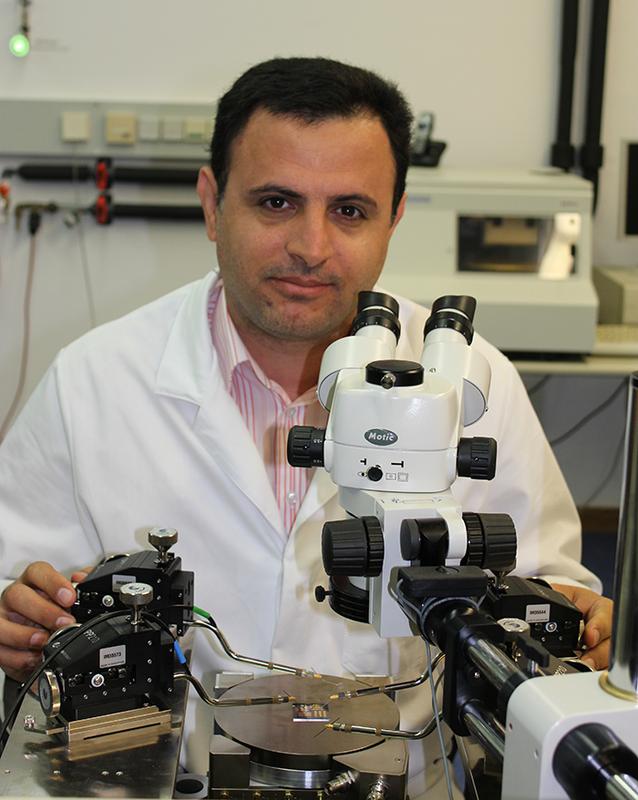Devices for organic high-capacity memories

Dr. Kamal Asadi receives the Sofja Kovalevskaja Award MPIP
With this award, which is endowed with 1.65 million euros, the Humboldt Foundation singles out outstanding research talents with innovative research methods. Kamal Asadi is working at the MPI-P as a project leader, investigating electronic devices based on organic materials. The award enables him to develop an independent research group at the MPI-P with protected financing over the coming five years.
Mainz/Bonn. Kamal Asadi from the Max Planck Institute for Polymer Research in Mainz receives one of the highest German scientific awards from the Alexander von Humboldt Foundation. He studies materials and physics of future organic memory devices.
“It is very exciting to step into an unexplored field thus far: organic multiferroics. And I’m really looking forward to actually changing the magnetization with the electric field,” Asadi says.
The hope for multiferroics
The Iranian born Kamal Asadi joined the group of Paul Blom at the MPI-P in 2013. Prior to that, he was a research scientist with the Dutch electronics group Philips. For many years, he has been conducting research on ferroelectric polymers, their materials science and device physics. His objective at MPI-P is develop organic multiferroics; composite materials that are simultaneously ferroelectric and ferromagnetics.
Ferroelectricity is the ability of certain dielectrics to demonstrate a non-zero polarization without an applied electric field, and is widely used in actuators, sensors and transducers. Ferroelectrics are also intriguing materials for memory applications due to their polarization bistability, which can be used as “0” and “1” states of the Boolean logic. Today’s memories like hard disk drives however are made of ferromagnetic materials. Ferromagnetism, a phenomenon widely known from permanent magnets, is based on the spin of the electrons and is observed mainly in metals.
Based on the classical Maxwell equations the scientific community was convinced that ferroelectricity and ferromagnetism are two mutually exclusive properties that cannot coexist in a single material. Nonetheless, in 1960s’ it was shown that there can be a weak interaction, or coupling, between ferroelectricity and ferromagnetism. Establishing the coupling between polarization and magnetization has been a challenge for experimental physicist for decades. Such material, called multi-ferroics, holds a promise for novel multi-functional data storage devices that can be written electrically and read magnetically.
Identification of multiferroic property in inorganic materials has led to worldwide research interest. Single phase multiferroics are rare, the coupling is weak and the electromagnetic response is only operative at very low temperatures. The alternatives to single phase are composites, and multi-layers of inorganic materials. The approaches have been promising, but there are still many scientific obstacles to overcome.
With the Sofja Kovalevskaja Award, Kamal Asadi is taking a totally different approach, using only organic materials. Developments of organic multiferroics that can be processed from solution are expected to lead to a revolution in novel switching devices, which is highly relevant for technology. It will be however a scientifically challenging task. For him, the first hurdle to overcome will be to build up his group at the MPI-P.
Award-winning and promoted Polymer Research
Once again a researcher of the MPI-P has succeeded in applying successfully for a conveyor price with long-term financing. During the past three years five ERC-Grants and as well as numerous participation in special fields of investigation (SFB) were donated. The MPI-P has developed with his infrastructure and his interdisciplinary adjustment to a centre of attraction for high talented researchers. This is a synergetic increasing effect which is based on wide recognition of the research achievements and the innovation potential of the institute.
Top Award for excellent research talents
The Sofja Kovalevskaja Award is one of the most valuable academic awards in Germany and allows the recipients to carry out research work under unique conditions: They may spend five years working on a research project at a university of their own choice in Germany and build up their own working groups – independently and largely untroubled by administrative constraints. The award amount may total up to 1.65 million euros per award winner. The objective is to integrate internationally sought-after research talents into collaborations with academics in Germany right at the beginning of their highly-promising careers, profiting both the research location and especially junior researchers in Germany. The award, which is granted for outstanding talent and a creative approach to research, is funded by the Federal Ministry of Education and Research.
About the Max Planck Institute for Polymer Research
The Max Planck Institute for Polymer Research, which was founded in 1984, ranks among the world-wide leading research centers in the field of polymer research. The focus on so-called soft materials and macro-molecular materials has resulted in the worldwide unique position of the Max Planck Institute for Polymer Research and its research focus. Fundamental research on both production and characterization of polymers as well as the physical and chemical properties analysis of polymers are conducted here by scientific collaborators from all over the world. In the beginning of 2014 a total of 518 people were working at the MPI-P. The work force was made up of 121 scientists, 147 doctoral and diploma students, 76 scholarship holders, and 174 technical, administrative and auxiliary staff.
Media Contact
All latest news from the category: Awards Funding
Newest articles

Properties of new materials for microchips
… can now be measured well. Reseachers of Delft University of Technology demonstrated measuring performance properties of ultrathin silicon membranes. Making ever smaller and more powerful chips requires new ultrathin…

Floating solar’s potential
… to support sustainable development by addressing climate, water, and energy goals holistically. A new study published this week in Nature Energy raises the potential for floating solar photovoltaics (FPV)…

Skyrmions move at record speeds
… a step towards the computing of the future. An international research team led by scientists from the CNRS1 has discovered that the magnetic nanobubbles2 known as skyrmions can be…





















